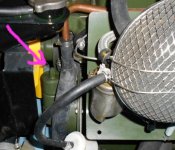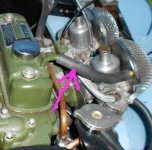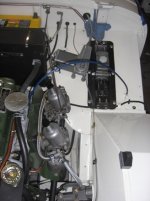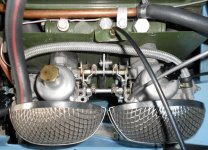Offline
OK, I've read a lot of old threads on this topic, such as: https://www.britishcarforum.com/bcforum/ubbthreads.php/topics/756957/PCV_installation_results . What I guess I don't fully get are all the various set-ups for crankcase ventilation... some with non-ventilated rocker-covers, some with open ventilated oil separators, some with PVC hook-ups to oil seperators, etc. I realize that some are for different engines (notably later 1275s like mine vs. stock 948s).
I've got a 1275 (with dual HS2s) with a front oil seperator that just opens to the air, and a rocker cover that vents by a hose to a carb air-filter. It seems to work. However, I'm wondering if I should consider piping the oil seperator to a PCV to the standard intake manifold access fitting/plug (in the middle between the carbs). Some seem to think this is essential to minimize pressures on seals. Beats me.
I'm not trying to solve an oil leak or anything (well, not right now). Just playing the tweak game. All the various set-ups are confusing my little mind.
All the various set-ups are confusing my little mind.  Once in a while I have blown a little oil into a carb under severe load.
Once in a while I have blown a little oil into a carb under severe load.
Related questions: if one is using a ventilated rocker cover, does a PCV even make sense? I mean, is any vacuum draw even workable/useful in that situation? I used to have a 1293 Mini with a non-ventilated (sealed) rocker and it worked great. Also, IF this is worth installing, could I use any old barbed PCV from an auto store (vs. the old style metal one with the diaphragm)? In short, what do you use and does it work well?
I value all your opinions. Thanks.
I've got a 1275 (with dual HS2s) with a front oil seperator that just opens to the air, and a rocker cover that vents by a hose to a carb air-filter. It seems to work. However, I'm wondering if I should consider piping the oil seperator to a PCV to the standard intake manifold access fitting/plug (in the middle between the carbs). Some seem to think this is essential to minimize pressures on seals. Beats me.
I'm not trying to solve an oil leak or anything (well, not right now). Just playing the tweak game.
 All the various set-ups are confusing my little mind.
All the various set-ups are confusing my little mind.  Once in a while I have blown a little oil into a carb under severe load.
Once in a while I have blown a little oil into a carb under severe load.Related questions: if one is using a ventilated rocker cover, does a PCV even make sense? I mean, is any vacuum draw even workable/useful in that situation? I used to have a 1293 Mini with a non-ventilated (sealed) rocker and it worked great. Also, IF this is worth installing, could I use any old barbed PCV from an auto store (vs. the old style metal one with the diaphragm)? In short, what do you use and does it work well?
I value all your opinions. Thanks.


 Hi Guest!
Hi Guest!

 smilie in place of the real @
smilie in place of the real @
 Pretty Please - add it to our Events forum(s) and add to the calendar! >>
Pretty Please - add it to our Events forum(s) and add to the calendar! >> 




